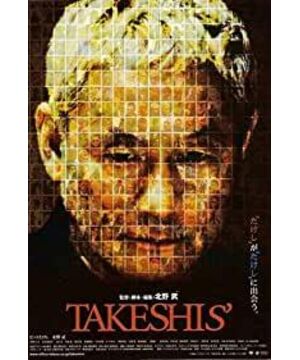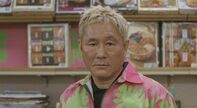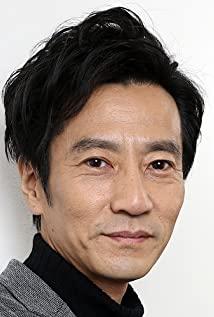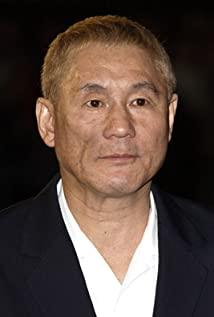Takeshi Kitano's recent films have too many similar film language, similar to Brecht's performance system, and he often looks at the role beyond the role itself. For example, in "Long Live the Director", it often becomes a doll. "Double-faced Takeshi Kitano" is often found in dreams. Too much of the director's own understanding was added to this film and he was visualized. This kind of personal narrative can be difficult for everyone to understand. Of course, it is also because of the personalization that makes it different from the genre films that please the audience. However, Takeshi Kitano's humorous narration in the film can raise the interest of attention.
A small number of characters play a variety of roles in one film, coupled with the unique film language in Kitano Takeshi's film (such as: character freeze), the film is closed, like a story in a closed space.
2 The interspersed life experiences of Takeshi Kitano, actors, tap dancers, taxi drivers, etc., are all that Takeshi Kitano once worked. The appearance of all these is more like a review of Takeshi Kitano's experience, which can also make him more proficient. The analytical structure itself.
None of the above matters.
What impresses me most about this film is the way it manifests itself. It's the way the subtext is spoken.
For example, the sudden insertion of scenes that have nothing to do with the narration in the film, and these scenes do not participate in the narration like flashbacks, it seems to be an evaluation, which is separated from the evaluation outside the film. This feeling seems to be a bit Brecht (my understanding of Brecht is very one-sided, and it is inevitable to make mistakes). This kind of insertion is not groundless, it is actually a manifestation of consciousness. Almost all movies now do not tell the subtext. You can guess what he may mean from the movie. There is one in a thousand people's eyes. Thousands of Hamlets, so the understanding of the plot of the movie is also everyone's opinion. The method of manifesting consciousness directly visualizes what the director thinks in his mind. It seems that this will stifle the audience's other understanding and imagination, but showing the director's inner world can also allow the audience to interpret his thoughts. That is, the understanding of the director's consciousness of video. The starting point of this understanding is at the director's thinking level. If you understand the film, at least the director's narration will not be greatly deviated. Of course, this act of stifling Guan Zhong's understanding of first-world images does reduce some of the expressiveness of the film.
Or this kind of film is never a film that presents some real world (documentary). Because the film has added too many personal understandings of the director and distorted the reality, but this is the most authentic documentary film understood by the director, because it touches the director's thinking level and directly opens the director's brain to show the image. There's never been a movie of that kind that has more depth than this.
Personalized thinking can actually be interpreted by everyone, and in this way, the director and attention may have other benefits.
The visualization of thinking in film is not just the sudden insertion of fragments. In fact, many movies also have this kind of narration, visualizing thinking, such as making some voices in reality louder. In the film, Kitano Takeshi's neighborhood is always discussed, and it is always used to shout. But when he met Takeshi Kitano face to face, he was very polite. Then it can be understood that in reality, they have always been speaking in a low voice, and their words will be amplified very loudly in Kitano Takeshi's world. What we see is the world of Takeshi Kitano.
Another way is to move things in consciousness into reality and participate in the narrative. For example, when someone gives the cashier Takeka Kitano, a small bug comes out. A strange passenger met by Takeshi Kitano, the driver. In the end, the confrontation between the killer Kitano Takeshi and the police, the evaluation of Kitano Takeshi by a black-clothed woman who often appeared, the gang boss who repeated the ramen restaurant standing next to the boss, and Kitano Takeshi turned into the boss of the clown when he ate noodles for the second time... etc.
In this way, things in consciousness seem to have participated in the narrative, but in fact it is just the usual development of things in reality. For example, in "Dueling Club", the appearance of Brad Pitt did not change the reality, it was Edward Norton who changed the reality. The emergence of Brad Pitt is an explanation, so the conscious level will only explain the reality, not really participate in the narrative. "Duel Club" is absolutely a perfect narrative, and other movies have similar things, when consciousness is involved in the narrative too much or even when consciousness changes reality, it usually interrupts consciousness---tell everyone that it was just a dream .
There are actually a lot of YY in real life, but the movies show it too much, but ignore the YY under normal understanding.
There is so much to say in this film of Takeshi Kitano.
In his second world (consciousness), the ridicule of others to him is ignored, and the viciousness of this world is told by him in images, and this is not just the negative side of the world. During the shootout, the flickering gunfire turned into constellations also let us see the cuteness of Takeshi Kitano. Of course, Takeshi Kitano's own attitude in the movie is Takeshi Kitano's attitude. To bear, to vent, to know the ups and downs of suffering.
View more about Takeshis' reviews











